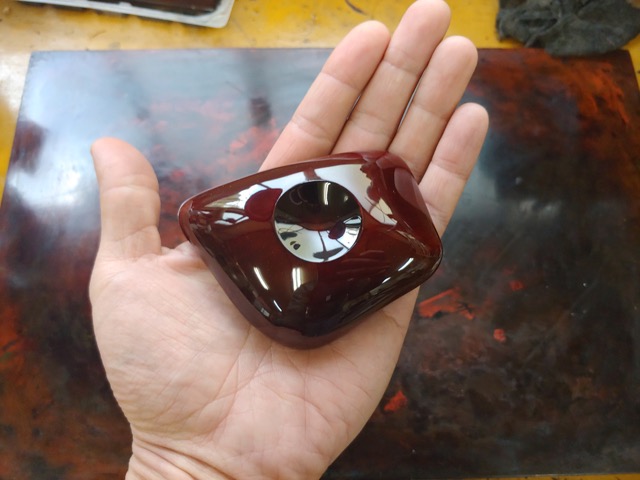„Feelings are something that we all have, something that we can all relate to. They are inseparable from the human condition. But where do they come from? Why do some of us feel stronger feelings towards certain things more than others? Feelings are powerful. They’ve guided us and inspired us since the beginning. The expression of feeling can be as abstract as the feelings themselves. From poetry to dance to music to art, all in a way to decipher our inner selves in hopes that some, even if only a few, can relate to us. Sometimes I wonder if we are able to capture them in their entirety or whether we even completely understand our own. They exist for us to wonder and for us alone.
Being here at the studio tucked away in nature surrounded by the very trees that provide this beautiful material that we love, it is impossible not to feel a deeper connection to urushi. As I’ve tended to the trees, watched how they’ve changed with the seasons and witnessed their coexistence with other living organisms, my relationship to urushi has grown more intimate. And with time this relationship has also provided me with more meaning in my work.
In my first post I briefly mentioned that upon arrival to Gansen Urushi Studio my first experience with urushi was not in the studio, but in Onishi sensei’s gallery at home. He asked me not to only see and touch, but more importantly to feel. As I kneeled there holding some of his pieces I could feel an energy and life contained within them. What I’ve now come to learn as the Buddhist concept of 気or “Ki”. When I returned back to the studio sensei proceeded by opening a box filled with small objects, or “hand sculptures” as he preferred to call them, and told me to hold them and move them around in my hands. And with a warm smile sensei expressed, “Urushi should feel soft.”
Little did I know at the time, but that experience and those words would be the foundation for my learning here at the studio and still something that I think about every day. “Urushi should feel soft.” I’ve come to realize now that sometimes just a few words can actually carry the deepest meanings once I’ve taken the time to give them some consideration. I have thought about these four words quite a lot during my time here and would like to share my thoughts thus far and hopefully inspire others to seek out their own experience with urushi.
When one interprets a material as “soft,” it may be easy to assume that it is weak, however, urushi is anything but. Urushi is actually one of the most durable natural materials known to mankind with objects having endured history through thousands of years of cultural and environmental changes. It has been used on everything from temple structures to armor to furniture to bowls. Sensei actually uses lacquerware that is over 300 years old for all of his meals every single day.
Then there is touch, the physical feeling. In the beginning, I limited my perspective by assuming that sensei was referring only to the touch of the finished piece. The process of an urushi work can take anywhere from about 30 steps for the most basic to double that or even more for highly shaped or decorative work. In working with urushi I have discovered that the sensation of softness is equally as relevant in the groundwork as it is to the final applications and to the finished piece you get to touch.
So what that leaves us with are those “other” feelings. The indescribable ones. The emotional and spiritual feelings that touch us deep within. They define our humanity and connect us all together. They are our muses and inspire us to create in search for meaning and understanding of our existence. We attempt to express those inner feelings into something that can be experienced and enjoyed. This is the greatest challenge that lies in front of every artist. Sensei always says to “Make with feeling” because it is the feeling from the heart that will always show the trust. I’ve often wondered about why certain things in my life seem to possess a certain gravitational pull into my soul. A force stronger than anything my mind can comprehend.
Urushi is special and its beauty profound. I cannot stress that enough. Urushi possesses incredible depth in its presentation of color and clarity as well as in its meaning to humankind. It was born from nature before we were. It is a material that was chosen to honor the Gods as well as to support people. The pace of urushi work has a lot of shared meaning with life and it requires immense attention and care. Its temperament changes with the weather and the environment. If you work it too much or try to cure it too quickly the results are disappointing and you’ll likely be starting over. In order to achieve the best results, you must listen.
Urushi artists will often sing hymns when they speak of urushi and its beauty. Of how special it is and unlike any other material. Of how it contains a life force of its own that we likely won’t ever fully understand. As I sit here working, moving the spatula back and forth and watching the brush strokes disappear as urushi glides across the surface I get lost in a trance. So I’m left pondering, always thinking and always creating, learning and discovering more of myself each day. Almost every week since coming to the studio, Onishi sensei’s assistant, Izumi, always asks me, “What does urushi make you feel?”“
-Written by Hugh Hung




Hinterlasse einen Kommentar